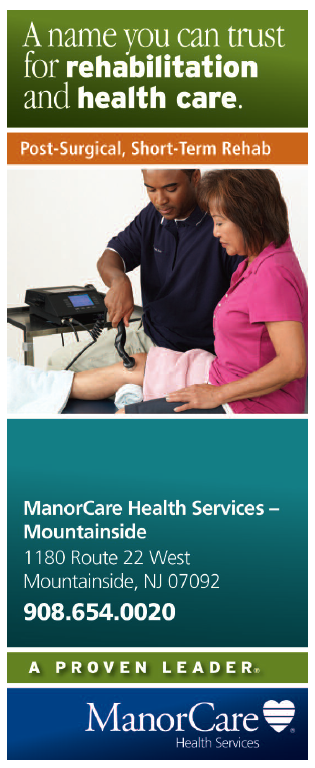With each 9-1-1 call, two award-winning Trinitas teams spring into action.
Terror. Pain. Confusion. A swirl of sounds and people. The fear that this might be a one-way trip. This is the part of a cardiac emergency you don’t see on TV medical dramas. Yet it is in these first moments when help arrives that difference-making action begins. The target window of time during which an individual in this situation needs to receive emergency care is 90 minutes—so says the American Heart Association. Which is why the right call is a 9-1-1 call. Indeed, according to Gerard “Rod” Muench, Trinitas Regional Medical Center 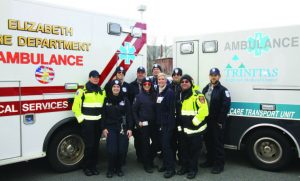 Administrative Director of the Emergency and Emergency Medical Services Departments, a good chunk of that critical window can be wasted by driving that individual to the hospital in a personal vehicle. Dialing 9-1-1 initiates a System of Care that makes the most of those precious minutes.
Administrative Director of the Emergency and Emergency Medical Services Departments, a good chunk of that critical window can be wasted by driving that individual to the hospital in a personal vehicle. Dialing 9-1-1 initiates a System of Care that makes the most of those precious minutes.
Trinitas has been the recipient of Mission: Lifeline awards from the American Heart Association in each of the last four years. The departments receiving this honor are under the director- ship of Muench and Kathleen Azzarello, head of Cardiovascular Services—two professionals who excel at administering critical emergency-treatment response. Muench’s team is focused on saving the lives of severely distressed cardiac (and other) patients by streamlining the trip of EMS personnel from point of contact to the Emergency Department at Trinitas. Azzarello’s team, which includes the cardiac catheterization lab, is at the receiving end when the ambulance arrives with patients in cardiac distress.
Muench and his team deliver approximately 1,000 patients each year to Azzarello and her staff. On average, their coordinated care probably saves 50 patients a year—about one a week—whose extreme coronary distress would have resulted in death under almost any other scenario.
The Three C’s
The common goal of emergency System of Care protocols can be defined by three important C’s: Cooperation, Collaboration and Communication. The goal of the EMS team is to administer treatment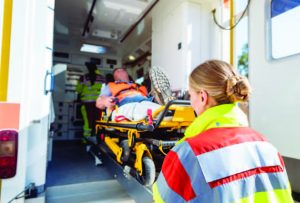 at the very first moment that the EMTs make contact with the patient. Trinitas pre-hospital personnel is trained in procedures such as administering CPR, providing medication, inserting an IV, and transmitting an EKG to the hospital prior to the patient’s arrival. Once delivered to the Emergency Department, no time is wasted in turning over those in need of immediate cardiac care to the Cardiovascular Services Department.
at the very first moment that the EMTs make contact with the patient. Trinitas pre-hospital personnel is trained in procedures such as administering CPR, providing medication, inserting an IV, and transmitting an EKG to the hospital prior to the patient’s arrival. Once delivered to the Emergency Department, no time is wasted in turning over those in need of immediate cardiac care to the Cardiovascular Services Department.
The overall success of response to cardiac emergencies starts with expediting what used to be called “door-to-needle” time. The clock starts ticking at the point of first medical contact—in the home, in the car, at work, or on the phone with a 911 dispatcher—and doesn’t stop until a patient is transported by an emergency vehicle to the catheterization lab or cardiovascular department, where life-saving treatment can be initiated before time runs out. At Trinitas, first contact typically goes through the hospital’s Mobile Intensive Care Unit. The MICU operates in coordination with the Elizabeth Fire Department, which initiates on-site stabilization and treatment.
Everyone trained and supervised by Rod Muench appreciates that every minute matters when it comes to coronary patient outcomes, making the MICU an “Emergency Dept. on wheels.” He has been at Trinitas for 11 years, previously served as ED/EMS Administrator, and is often described as a paramedic educator. He has developed and implemented a thorough regimen for the hospital’s staff of EMTs, including a first-contact philosophy.
“Learning how to communicate with the patient is key,” Muench explains. “Good people skills are essential to a good emergency medical technician.”
The need to combine empathy with speed and accuracy is echoed by Kathleen Azzarello and her team, which deals with extreme pressure 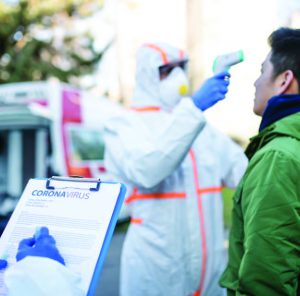 situations on a round-the-clock basis. In assembling that team, she looks for individuals who are “a bit of an adrenaline junkie,” adding that they need to stay calm under fire and also appreciate the ultimate rewards of being a critical caregiver. What is her reward?
situations on a round-the-clock basis. In assembling that team, she looks for individuals who are “a bit of an adrenaline junkie,” adding that they need to stay calm under fire and also appreciate the ultimate rewards of being a critical caregiver. What is her reward?
“It’s an amazing privilege to watch a cardiac patient go from near death upon arrival to wanting to leave the hospital as soon as treatment has been administered.”
Needless to say, COVID-19 has complicated the work of everyone involved in emergency care. It has also created a growing number of post-COVID coronary infections, a story that was under-reported in 2020. Given the added stress of the pandemic, Azzarello and Muench are understandably proud of the Mission: Lifeline recognition their teams received in 2020—the Gold Plus award to the ED/EMS departments and the Gold Mission: Lifeline for ST Elevation Myocardial Infarction (STEMI) Receiving Department. Neither, however, is quick to take personal credit.
STEMI
According to the CDC, even in the pandemic year of 2020, heart disease was the number-one cause of death in the United States. A quarter-million people fall victim to the most fatal type of heart attack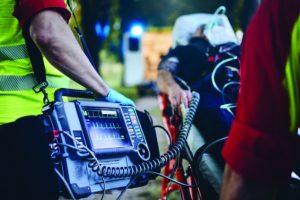 —ST Elevation Myocardial Infarction, or STEMI—which blocks blood flow to the heart. These extreme cases are prime examples of the difference that a 9-1-1 call to Trinitas can make.
—ST Elevation Myocardial Infarction, or STEMI—which blocks blood flow to the heart. These extreme cases are prime examples of the difference that a 9-1-1 call to Trinitas can make.
“I am only doing so well,” Muench points out, “because my staff at Trinitas is a unique breed of highly skilled and motivated people who make my job easier.”
“I am supported by a staff of passionate, humble and unspoiled individuals from diverse backgrounds,” adds Azzarello. “We have become a family that is willing to walk that extra mile to help a patient in need.”


